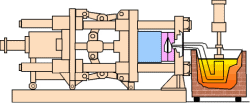The Zinc Die Casting Process. The zinc die casting process gives way to the construction of zinc die cast parts, which are made of zinc or zinc alloy tool steels. They each may have at least two sections, specifically the cover half, also known as the fixed die half, and the ejector die half; these divisions allow the easy removal of the castings from the machines. The ejector die half is what holds the passageways and inlets, all of which coax the molten metal to enter the cavity. Today, zinc die cast parts may also have movable cores, slides, and other sections in order to make various shapes. They also have locking pins that work to secure the two sections; openings for cooling and oiling purposes; and ejector pins that are designed to help take out the cast parts.
During that part of the zinc die casting process wherein the machine shuts, the two die sections are secured and held firmly together by the hydraulic pressure of the machine. The ejector die half and the fixed die half meet together and become locked in at a projected surface area called the die parting line. The clamping force of the die casting machine is controlled by the total projected surface area of the part being cast and the hydraulic pressure necessary for the said machine to inject the zinc metal or zinc alloy into the cavity. These days, die casting machines have the ability to load 250 tons to 1,600 tons, setting the annual production capacity of companies employing the zinc die casting process in 400 sets-molds and at least 20,000 zinc die cast parts.


